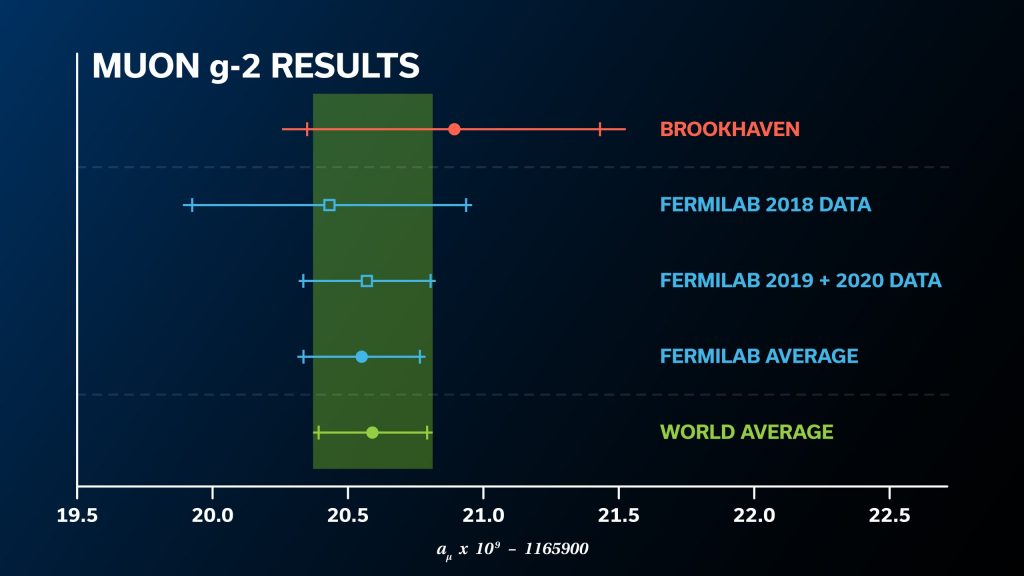On Thursday, August 10, the Muon g-2 experiment reported follow-up results to its 2021 measurements. There is something wrong with the muon, the heavier sibling of the electron. This fundamental particle is not behaving in the way it is predicted to by our best theory of the fundamental universe: the Standard Model of Particle Physics.
But one step at a time. The muon is like a chonky version of the electron: it has the same electric charge, but is almost 207 times more massive. As subatomic particles go, muons are unstable, decaying in a couple of microseconds, but that’s enough to do some cool science – most significantly, when the muon is accelerated close to the speed of light.
Special relativity tells us that time slows down the faster you go, so when accelerated these particles stay around for longer. This is why muons make up a lot of cosmic rays that can reach the ground. High-speed protons hit the atmosphere creating muons. These move so fast that despite their short lifespan, they can make it all the way down. The muon was discovered in cosmic rays.
The Standard Model is our best theory of particle physics. It has correctly predicted the existence of many particles, and explains so much about the fundamental forces that govern the universe. At the same time, it is hugely limited. It does not include gravity or the hypothetical dark matter and dark energy, which are expected to make up most of the universe.
This might seem like a contradiction. How can our best theory be so limited? But it is actually pretty good to have a theory with clear limits and yet great explanatory powers. The issue is that the limits are nowhere we can test. Until the muon came in. And in particular, its magnetic properties.
The Standard Model has a clear prediction for the magnetic moment of the muon, but the measured value at Brookhaven National Laboratory early this century hinted that it was not correct. Scientists decided that it was intriguing but needed to be tested further. And the best place to do that was Chicago, where they could create a purer beam of muons. So they had to take the whole experiment on a 5,000-kilometer (3,200-mile) trip from Long Island, New York down to Florida and through Tennessee to get to Fermilab just outside Chicago.

The experiment during the last leg of the trip.
Image credit: Fermilab
The work done at Fermilab confirmed that there is an anomalous magnetic moment and the new data analysis puts this to a never-before-seen confidence level. Their precision level is one part in 200,000.
“This measurement is an incredible experimental achievement,” Peter Winter, co-spokesperson for the Muon g-2 collaboration, said in a statement. “Getting the systematic uncertainty down to this level is a big deal and is something we didn’t expect to achieve so soon.”
Experiments improve their statistical uncertainty by collecting more and more data and analyzing it together. This value is not the full dataset of the Muon g-2 collaboration. That will be completed in the next few years.
“Our new measurement is very exciting because it takes us well beyond Brookhaven’s sensitivity,” added Graziano Venanzoni, professor at the University of Liverpool affiliated with the Italian National Institute for Nuclear Physics, Pisa, and co-spokesperson of the Muon g-2 experiment at Fermilab.

The value of the anomaly as it has changed through the years.
Image credit: Muon g-2 collaboration
So what is causing the anomalous magnetic moment to behave differently from the prediction? The researchers compared the magnetic moment within the theoretical framework, as the muon can have different “dance partners” that produce the value. But theory is clearly missing a sneaky partner, one that is not present or accounted for in the Standard Model. Theoreticians are working on this problem and the goal is that when the final data is announced in 2025, new theoretical predictions will also be published.
The Standard Model continues to serve us very well to understand the universe, but it is very exciting that we are starting to look beyond it.
The findings are reported in an as-yet unpublished paper that has been submitted to Physical Review Letters.
Source Link: What Are The Claims of "New" Physics From The Muon g-2 Experiment All About?